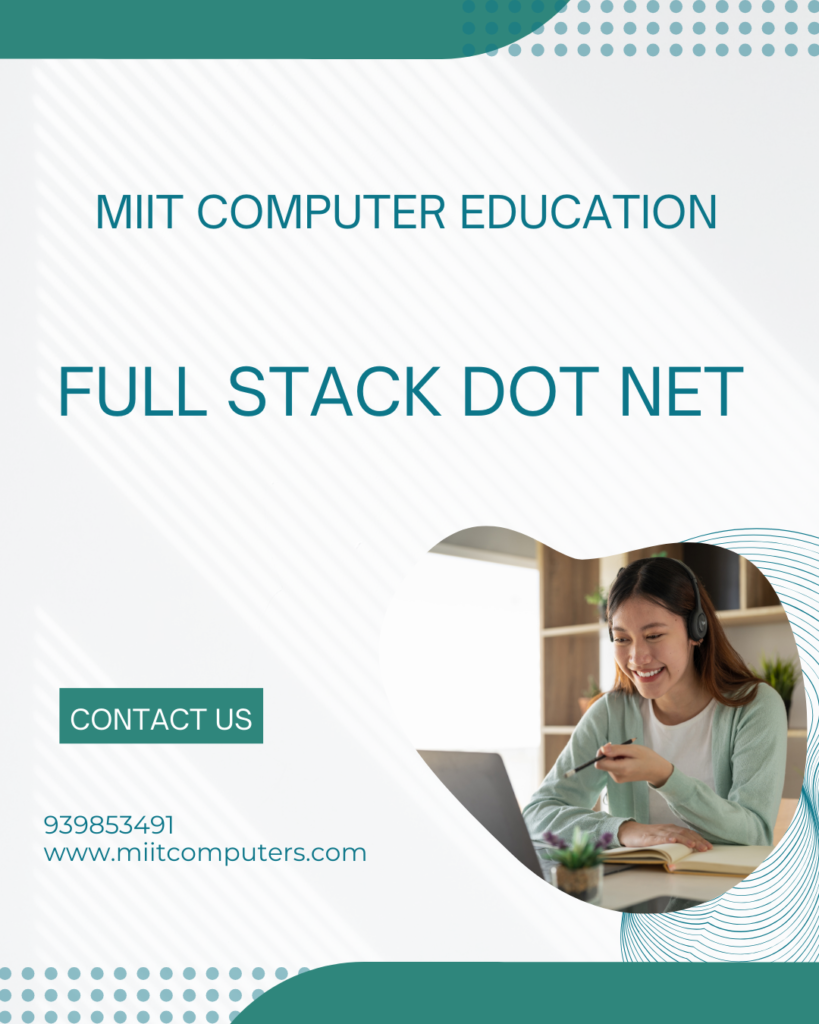Full Stack Dot Net
A Full Stack .NET course is designed to equip individuals with the comprehensive skills needed to develop and deploy complete web applications using the Microsoft .NET ecosystem. This involves mastering both the front-end (client-side) and the back-end (server-side) technologies within the .NET framework.
Here’s a breakdown of what a typical Full Stack .NET course might cover:
I. Front-End Development (Client-Side):
- HTML (HyperText Markup Language): The foundation of web page structure and content.
- CSS (Cascading Style Sheets): Styling and layout of web pages for visual appeal and responsiveness.
- JavaScript: Adding interactivity and dynamic behavior to web pages.
- Front-End Frameworks/Libraries:
- Angular: A comprehensive framework for building complex single-page applications (SPAs).
- React: A popular library focused on building user interfaces with a component-based architecture.
- Blazor: A framework that enables building interactive client-side web UI with C# instead of JavaScript. This is a significant aspect of the .NET full stack.
- Responsive Web Design: Techniques for creating websites that adapt seamlessly to different screen sizes and devices (desktops, tablets, mobile).
- UI/UX Principles: Basic understanding of user interface design and user experience principles to create user-friendly applications.
- Version Control (Git): Using Git for managing code changes and collaboration.
II. Back-End Development (Server-Side) with .NET:
- C# (C Sharp): The primary programming language for the .NET framework.
- .NET Framework / .NET Core / .NET (Latest Version): Understanding the evolution and core concepts of the .NET platform for building various types of applications.
- ASP.NET Core: A modern, cross-platform framework for building web applications and APIs.
- MVC (Model-View-Controller): An architectural pattern for structuring web applications.
- Razor Pages: A page-focused programming model that simplifies web development.
- Web API Development: Building RESTful APIs for communication between the front-end and back-end.
- Entity Framework Core (EF Core): An Object-Relational Mapper (ORM) that simplifies database interactions using C#.
- Database Management:
- SQL Server: Microsoft’s relational database management system (RDBMS).
- Understanding database design, querying (SQL), and data management.
- Authentication and Authorization: Implementing secure user authentication (login) and authorization (access control) mechanisms.
- State Management: Techniques for managing application data across user sessions and requests.
- Dependency Injection: A design pattern for managing dependencies between different parts of the application.
- Unit Testing and Integration Testing: Writing tests to ensure the reliability and correctness of the back-end code.
- Security Best Practices: Understanding and implementing security measures to protect against common web vulnerabilities.
III. Full Stack Integration and Deployment:
- API Integration: Connecting the front-end with the back-end APIs to exchange data.
- Deployment: Understanding different deployment environments (e.g., IIS, Azure) and processes for deploying .NET applications.
- Cloud Technologies (Optional but Increasingly Important): Introduction to cloud platforms like Microsoft Azure for hosting and managing applications.
- DevOps Fundamentals (Optional): Basic understanding of continuous integration and continuous deployment (CI/CD) pipelines.
Learning Outcomes:
Upon completing a Full Stack .NET course, individuals should be able to:
- Develop interactive and responsive front-end user interfaces using HTML, CSS, JavaScript, and a modern framework/library (Angular, React, or Blazor).
- Build robust and scalable back-end applications and APIs using C# and ASP.NET Core.
- Interact with databases effectively using Entity Framework Core and SQL Server.
- Implement user authentication and authorization.
- Understand and apply security best practices in web development.
- Integrate front-end and back-end components seamlessly.
- Deploy .NET applications to various environments.
- Utilize version control with Git effectively.
- Understand the fundamentals of the full web development lifecycle.
Course Formats:
Full Stack .NET courses are offered in various formats, including:
- Bootcamps: Intensive, immersive programs focused on quickly acquiring full-stack skills.
- Diploma and Certificate Programs: More structured programs offered by educational institutions.
- Online Courses: Flexible learning options available on various e-learning platforms.
The specific technologies and depth of coverage may vary depending on the course provider and duration. However, the core goal is to empower individuals to become proficient full-stack .NET developers capable of building complete web applications from the user interface to the database.

Full Stack Dot Net Course - Frequently Asked Questions
Full Stack .NET development involves having the skills and knowledge to work on all tiers of a web application built using Microsoft technologies. This includes designing and implementing the user interface (front-end), handling the server-side logic and data (back-end) using .NET frameworks, and managing the database.
- High Demand: .NET is a widely used and mature technology stack, leading to numerous job opportunities in Hyderabad and globally.
- Versatility: You can build various types of applications, from web applications to APIs and more.
- Strong Ecosystem: Microsoft provides a comprehensive set of tools, libraries, and frameworks.
- Large Community Support: A vast and active community offers ample resources and assistance.
- Career Growth: Full-stack developers are highly valued for their ability to handle diverse aspects of a project.
Prerequisites can vary, but generally, some basic understanding of:
- Basic Computer Skills: Familiarity with operating systems and file management.
- Programming Concepts: Understanding of fundamental programming concepts like variables, loops, and conditional statements (prior experience in any language is a plus).
- Logical Thinking: Ability to break down problems and develop logical solutions.
Some advanced courses might expect prior experience with web development basics (HTML, CSS) or object-oriented programming.
As detailed in the previous description, you’ll typically learn:
- Front-End: HTML, CSS, JavaScript, and a modern framework/library like Angular, React, or Blazor.
- Back-End: C#, .NET Framework/.NET Core/.NET (latest), ASP.NET Core (MVC, Razor Pages, Web APIs), Entity Framework Core.
- Database: SQL Server and SQL.
- Tools: Visual Studio, Git, potentially Azure for deployment.
The duration can vary:
- Bootcamps: Typically range from 3 to 6 months of intensive, full-time study.
- Diploma/Certificate Courses: Can be 6 months to a year or longer.
- Online Courses: Self-paced learning can vary, but structured online programs might take several months.
What Are You Looking For? Come Join Us!
